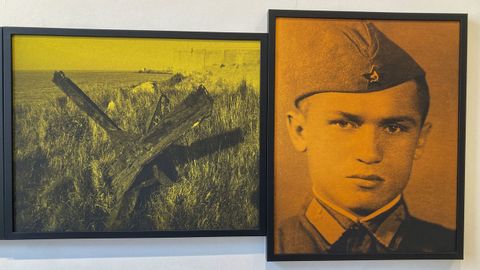
Author: Enrique Rubio | EFE
British artist Piers these days exhibits a pattern on the one located in Alderney, one of the UK’s Channel Islands
All countries strive in one way or another to erase the most dishonorable traces of their past, as is the case with the infamous Nazi concentration camp on Alderney, one of the British islands in the English Channel, whose existence still remains a mystery to the British themselves.
Determined to focus on where barbarism buries civilization, British artist Piers Secunda (1976) these days exhibits the fruit of his research on Alderney, passed through the sieve of artistic creativity to have a more direct impact on the public.
Sample Alderney: Holocaust on British soilat the Arc Gallery in London, reveals the findings of Secunda and the group of forensic scientists he works with, such as the only firing squad that Nazi Germany ever had in Great Britain.
The archipelago of small islands dependent on the British crown off the French coast – of which Jersey is the most famous – was occupied by Nazi Germany from the summer of 1940 until the end of the war.
The German presence is well documented, but less so the labor camps that were established in Alderney, one of which will become concentration camp for Jews and political prisoners from countries such as Spain, France, Germany, Poland and, mainly, Russia. “It is very little known, especially since it is not taught in schools. If you go down the street and ask someone if they know there was a concentration camp in the UK, most people will think it’s a joke,” says Secunda.
For the artist, who before exploring Alderney examined the trail of cultural destruction left by the Taliban and Islamic State, “it’s natural for politicians to downplay difficult things and give them to others who are positive”. Not for nothing, for the United Kingdom it was “uncomfortable and even humiliating” to see that the Allies, despite the fact that they landed on the shores of Normandy in June 1944, only a year later, with the end of the war in Europe, when the Nazis left the channel islands.
Alderney, in fact, surrendered only on May 16, 1945, eight days after the German capitulation. “They were fans. The commander was personally selected by (SS chief Heinrich) Himmler and was instructed not to return the islands to the United Kingdom. They knew they were surrounded, that the war was over, but they fought endlessly,” says Secunda.

Author: Piers seconded | EFE
And in the middle of that islet of less than 8 square kilometers, fortified like a porcupine, the Sylt prison, which became a concentration camp after the arrival of the SS contingent in 1943.
a few clues
Only a few pillars remain where the site once stood. It is impossible to know such elementary data as the number of people who passed through it or how many of them died. Although the first count put the figure at 400 dead, Secunda believes there were many more.
During the entire year that passed from the Normandy landings to the end of World War II, Nazi officials managed to get rid of or hide the documentation. Fortunately, the testimony of the rescued captives remained in history.
How to turn horror into art? For Secunda, “by creating these works, I’m making a statement of intent, which is the most important thing an artist can do.”
“All art is about something: if it doesn’t have a theme, if it doesn’t communicate, it’s not art. Art is a communication system. What I wanted to say is that when you physically encounter these works, you get an emotional response that you won’t have if you simply look at some pictures on television or in the newspaper,” he believes.
The exhibit highlights a cast Secunda made of the bullet-riddled execution wall, which was confirmed by forensic experts Nicholas Petraco and Peter Diaczuk.
“This is the firing squad execution wall. And the section shows bullet impact marks made by Mauser rifles. “The smallest ones, according to forensic experts, are the result of the bullet slowing down after passing through materials, such as the human body in this case,” he explains.
Also on display are reproductions of documents, personal testimonies and photographs found in the field, which Secunda treated in order to present them as works of art that attract attention with their bright colors.
“The vibrant colors come from photos of flowers and plants I took on my mobile phone in Alderney, which is famous for its wildflowers. And the black color is gunpowder, cordite from a German artillery piece that one of my friends opened and burned,” he adds.
With this combination, Secunda intends to recreate “the contrast between the incredible beauty of the island, with its turquoise sea, beautiful beaches and those flowers, and that dark history of occupation, mass murder and forced labor.”
Source: La Vozde Galicia
I am David Miller, a highly experienced news reporter and author for 24 Instant News. I specialize in opinion pieces and have written extensively on current events, politics, social issues, and more. My writing has been featured in major publications such as The New York Times, The Guardian, and BBC News. I strive to be fair-minded while also producing thought-provoking content that encourages readers to engage with the topics I discuss.







